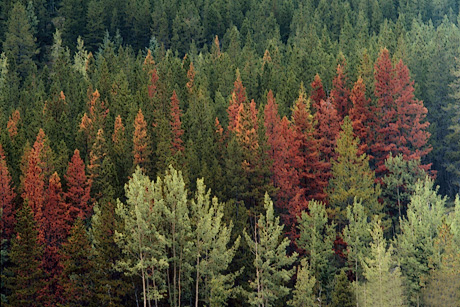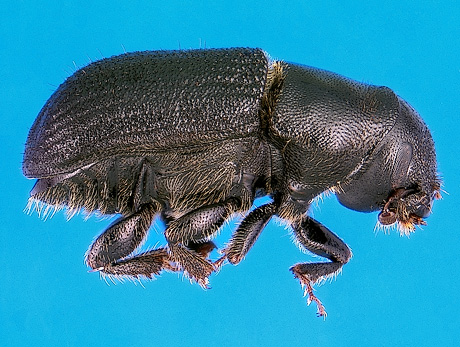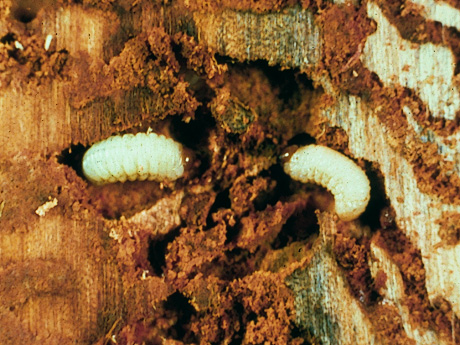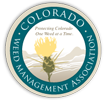
Mountain Pine Beetle
Damage caused by mountain pine beetles
Mountain pine beetles are the most important insect pest of Colorado's pine forests. They can kill millions of trees during an epidemic, which occur about every 10 to 30 years.
The mountain pine beetle attacks mostly stressed, mature (over 8" in diameter) ponderosa pine and lodge pole pines. During an epidemic they may attack almost all the large trees in the area.
The mountain pine beetle tunnels into the trunk and lateral branches 6" or more in diameter, feeding on the inner bark, disrupting the flow of water and nutrients in the tree. The beetles also spread blue stain fungus which also disrupts the flow of water and nutrients. The combination of beetle and fungus often kills the tree within a few weeks, but it may take almost a year for the needles to turn red.
The blue stain fungus gives the wood a blue-gray color reducing its value as timber.
 Daniel Miller, USDA Forest Service, Bugwood.org
Daniel Miller, USDA Forest Service, Bugwood.org
How to identify mountain pine beetles
Adult mountain pine beetles are about 1/5" long, brown to black, with a stout cylindrical shape to their body. The hind wing cover smooth, not spiny like other dark tree attacking beetles. The mountain pine beetle larvae are white with brown heads, about 1/4" long.
Pitch tubes, reddish boring dust, increased bird activity around trees, reddish needles and blue stained sapwood are all signs of mountain pine beetle infestation.
 Erich G. Vallery, USDA Forest Service - SRS-4552, Bugwood.org
Erich G. Vallery, USDA Forest Service - SRS-4552, Bugwood.org
Life cycle of the mountain pine beetles
Most adult mountain pine beetles exit trees where they have been developing in July and August, at lower elevations they can emerge as early as March and as late as November.
The females seek out new suitable trees and tunnel under the bark. Unmated females release pheromones that attract males and other females. After mating, the female mountain pine beetle tunnels out an egg gallery and lays about 75 eggs.
The larvae hatch in 7-14 days and start feeding. They overwinter in the inner bark and continue feeding until they mature, about June or July, when they pupate and change into adult mountain pine beetles.
The adults feed on the inner bark and then tunnel out through the bark and leave for a new tree in July and August.
The mountain pine beetle usually has one generation per year, but may require two years in cool years.
 Whitney Cranshaw, Colorado State University, Bugwood.org
Whitney Cranshaw, Colorado State University, Bugwood.org
How to control the mountain pine beetles
Natural predators, extreme cold temperatures and healthy well-spaced trees usually keep the mountain pine beetles under control, but during a mountain pine beetle epidemic pesticide sprays may be required to save individual trees. Preventative sprays may prevent mountain pine beetles from attacking trees. It is very had to save a tree once it has been infested with mountain pine beetles. Trees that have been killed by the beetles should be peeled, burned, buried or removed to prevent the beetles from attacking nearby trees.
 USDA Forest Service - Ogden Archive, USDA Forest Service, Bugwood.org
USDA Forest Service - Ogden Archive, USDA Forest Service, Bugwood.org
Other resources





